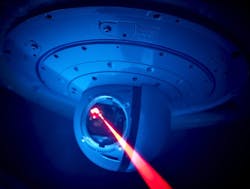Northrop Grumman to provide threat warning sensors for large aircraft infrared countermeasures system
PHILADELPHIA – U.S. military aerial warfare experts needed advanced threat warning (ATW) sensors for the AN/AAQ-24 large aircraft infrared countermeasures system (LAIRCM). They found their solution from The Northrop Grumman Corp. Mission Systems segment in Rolling Meadows, Ill.
Officials of the U.S. Defense Logistics Agency's aviation activity in Philadelphia announced a $12.5 million order to Northrop Grumman on Tuesday for AN/AAQ-24 threat warning sensors.
The Northrop Grumman AN/AAQ-24(V) LAIRCM electro-optical missile warning sensor is designed to provide missile-warning capability to protect large military aircraft from infrared-guided, heat-seeking missiles — particularly those from shoulder-fired launchers like the U.S.-made Stinger Block 2 and Russian-made SA-14 missiles.
The LAIRCM is a derivative of the AN/AAQ-24 Nemesis Directional IR Countermeasure (DIRCM) system. It jams the incoming missile’s seeker with a IR laser energy beam, and operates autonomously without intervention from the aircraft crew.
LAIRCM automatically detects a missile launch, determines if it is a threat, and activates a high-intensity laser-based countermeasure system to track and defeat the missile, Northrop Grumman officials say.
The system is for large aircraft like the Air Force C-5, C-17, C-37, and C-40 cargo and utility jets; Air Force C-130H and MC-130W four-engine utility turboprop aircraft, the CV-22 tiltrotor aircraft, the KC-46 aerial refueling jet, as well as the U.S. Navy P-3 maritime patrol jet. LAIRCM also can fit on some large military helicopters.
LAIRCM focuses high-intensity laser energy at the infrared seeker head of incoming missiles to blind the missile and force it off its target. The system is designed to protect large aircraft from shoulder-fired, vehicle-launched, and other infrared-guided missiles when the planes are operating close to the ground, such as on takeoff and landing, as well as during low-level operations and aerial refueling.
Initial LAIRCM systems equipped C-17 and C-130 aircraft as a stop-gap measure, using an ultraviolet sensor, a countermeasure processor, and a small laser turret assembly.
Later-model LAIRCM systems use a smaller laser turret, and operate in the infrared region. Compared to first-phase LAIRCM systems, the newer models provide better resolution, better performance in optical clutter, and increased range of detection.
In the future military leaders are trying to develop aircraft-protection infrared countermeasures able to detect and classify incoming missiles, then emit a custom jamming energy to defeat them.
On this order Northrop Grumman will do the work in Rolling Meadows, Ill., and should be finished by May 2022. For more information contact Northrop Grumman Mission Systems online at www.northropgrumman.com, or the Defense Logistics Agency Aviation activity at www.dla.mil/Aviation.
About the Author
John Keller
Editor-in-Chief
John Keller is the Editor-in-Chief, Military & Aerospace Electronics Magazine--provides extensive coverage and analysis of enabling electronics and optoelectronic technologies in military, space and commercial aviation applications. John has been a member of the Military & Aerospace Electronics staff since 1989 and chief editor since 1995.
